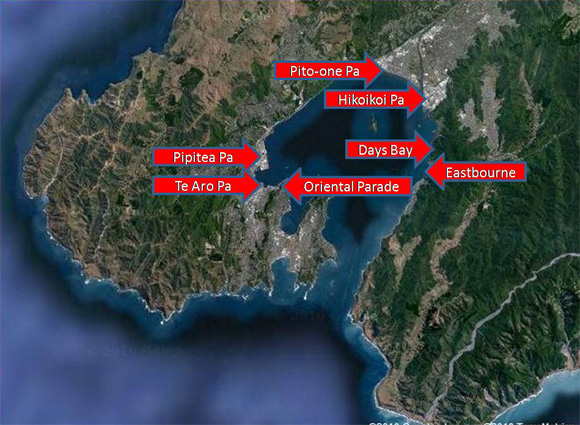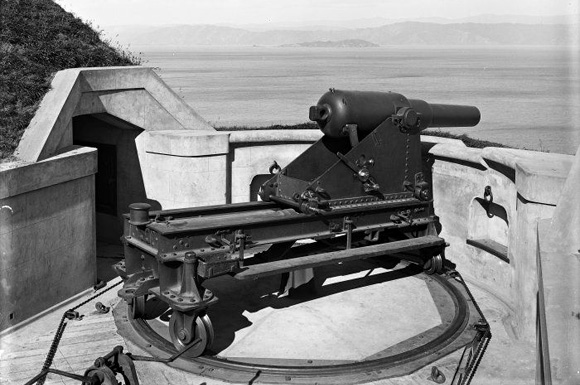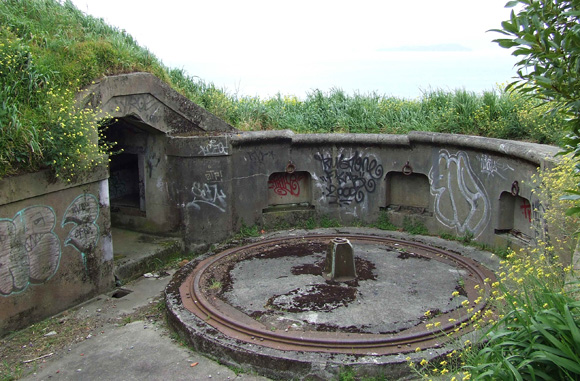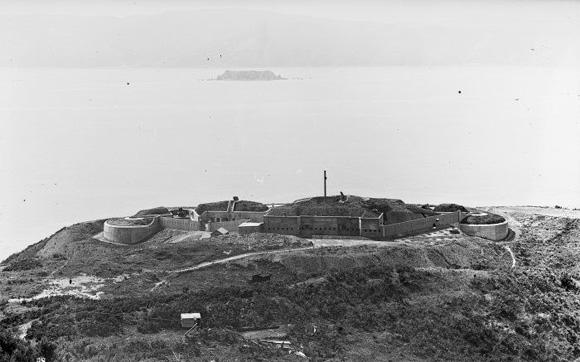|
Zeitblick
/ Das Online-Magazin der HillAc -
1. Januar 2011 - Nr. 38
|
City,
My City |
Series 4, Part 9 Fortress Wellington "A well regulated militia, James Madison, 4th President of the United States of America Tucked away on hillsides surrounding Wellington Harbour, amongst trees, overgrown with brush and on headlands and hilltops may be found some of the remnants of the various attempts undertaken by the New Zealand government to protect its shores from what was perceived at the time as real threats to our peace, our security and our sovereignty. Over the years various preparations have been made to secure our major harbours at Auckland, Wellington, Christchurch and Dunedin against expected attacks from Russia in the 1880's and Japan in the 1940's, attacks which fortunately did not occur but which were perceived as actual menaces in their day. Although Wellington has unfortunately lost Fort Kelburn, a memory from my childhood situated on the hills above the interchange joining state highways 1 & 2, and Fort Dorset, located on the shores of Wellington Harbour at Seatoun, history has retained for us forts Ballance and Buckley from the 1880's as well as Fort Opau on the North Island's south west coast near Makara, and the underground maze of tunnels that make up the Wright's Hill Fortress in the city's western hills. Although none of these guns was ever fired in anger (the occasional test firing did occur), and none of the installations was ever used for the purpose for which it was built, this story is dedicated to those who foresaw the dangers to our country, who took real steps towards repelling it and who decided that the value of New Zealand and its people was worthy of this effort and expense.
Throughout most of its human occupation Wellington Harbour (along with the rest of New Zealand) has been fortified to one degree or another. Protection for early Maori was created around the concept of fortified villages, known as "Pa" [literal definition being 'to obstruct'], often built on a hilltop, peninsula or headland jutting out into the sea, an arrangement which allowed for almost 360 degree protection from land-based attack. To enhance the security of this type of Pa the bulk of the neck of land linking it to the mainland was often hacked away leaving a narrow and easily defended access way. Maori Pa, formed by a combination of roughly circular palisades, ditches and embankments, were intended as domestic defensive positions only, each protecting its tribe or "Iwi" from its neighbouring tribes should there be any chance of aggression or surprise attack. I am not aware that there was ever any perception by Maori of the threat of invasion from beyond New Zealand's coastal waters. The country was remote enough to make any such venture in those days impractical. Economic and easy to construct [the so called "L-Pa" at Waitara in Taranaki was built overnight by 80 men] Pa were not utilised by their inhabitants as fortresses to withstand a sustained attack by soldiers with musket and cannon. It took, however, some years for the British regiments to figure this out. Well situated in defensive positions, the palisade was often raised a few centimetres above the ground to allow muskets to be fired from underneath rather than over the top, gaps were left in the palisade leading to killing traps and trenches and rifle pits were built to protect occupants. Should the battle not be going the defenders' way the Pa was willingly abandoned in favour of another location which, as we have found, could be quickly and easily barricaded. Wellington Harbour has been ringed by various Maori Pa built at one time or another over the centuries and there were at least 6 in existence when European settlers arrived in 1840 - Pito-One (or Petone), Hikoikoi, Pipitea and Te Aro as well as Pa at various other locations shown in the image above using their present-day English names. In addition two Pa were located on Somes (Matiu) Island in the centre of the harbour as well as one on Ward (Makaro) Island used as a 'Pa of refuge', where tribespeople could retreat in time of war.
The terms of the British Colonial Defence Act of 1865 allowed for any British colony to establish a navy, however little was done in New Zealand beyond appreciating the occasional presence of a British ship of war or gunboat along with, at that time, more than 10,000 British troops from at least 10 regiments. Some years later the serious fortification of New Zealand from external threat took place in two main stages - in 1876/77 and then in 1885, during what was termed the first and second "Russian Scare", and again from 1942 with the serious Japanese threat in the Pacific following the attack on Pearl Harbour during World War Two. Following the end of the Crimean War in 1856 and the defeat of Russia by a European alliance of armies including France, Britain and Turkey and other smaller states, the Russians seemed determined to continue to flex their military muscles. Several events occurred in the 1870's and 1880's which caused nations around the world to become increasingly suspicious of Russian intentions beyond its borders. The development of a fast and well-armed naval force by Tsarist Russia, whose Pacific ports were within sailing distance of Australian and New Zealand shores, caused the authorities in our young colonies to become increasingly aware of the vulnerability of our harbours and to attack by hostile forces. In February 1873 a New Zealand newspaper, the "Daily Southern Cross", published a story under the panic inducing headline "War with Russia, A Calamity for Auckland, Hostile Visit of a Russian Iron-clad". While this story was, as was later admitted by its authors, a well-intentioned hoax, the alarm generated was akin to that produced by Orson Welles' 1938 radio version of "The War of the Worlds" which featured an invasion of Earth by Martians. Many New Zealand citizens, obviously heedless of the footnote explaining the intent of the Russian invasion newspaper story, believed claims that the 954-man Russian warship "Kaskowiski" (a play on the phrase "cask o' whisky") with a dozen 30-ton guns and an advanced "water-gas" weapon had arrived in Auckland's Waitemata Harbour. In addition the Russians were said to have captured a British vessel anchored in the harbour, seized the city's munitions and gold reserves as well as holding several of its leading citizens to ransom. A day or two later the newspaper published a follow-up article explaining that the item was a pretence to prove the vulnerability of New Zealand and its harbours to attack. The ruse, however, had worked and the Government now saw how serious had become our distance from and reliance on Britain, the "Mother Country". Like Australia, New Zealand was a British Colony and as such we had always believed we could rely on Britain to defend us from harm. Logically, however, the probability of this defence being provided in time or even at all was becoming less and less likely and it was pragmatic for our government to take steps to defend New Zealand and its ports. Several reports were commissioned on the state of the colony's defences and planning commenced in earnest as a result of the "Russian Scare". The government bought 10 Armstrong BL-8 inch guns and 13 BL-6 inch guns on disappearing carriages [allowing the gun to sink into it's bunker for re-loading, keeping it out of the line of enemy fire]. This purchase was followed a short time later by the acquisition of a number of RML-7 inch and 64 pounder guns. It was now time to build the forts to house them.
In all 16 fortifications were built to protect the 4 key harbours in New Zealand - Auckland, Wellington, Christchurch and Dunedin. Four emplacements, Fort Ballance, Fort Buckley, Halswell Battery and Fort Kelburn, were built to protect Wellington between 1885 and 1889. All of these, with the exception of Fort Kelburn, remain today. The following is a brief run-down of the status of each of these existing emplacements: Fort Buckley Halswell Battery Fort Ballance
After their telling blow to American naval supremacy in the Pacific, the Japanese invading forces moved unfettered down through Asia and the Pacific and World War Two saw the appearance of another threat to New Zealand. As with the "Russian Scare" of 50 years before, defensive positions were built throughout New Zealand and in Wellington. This time, however, they were more extensive, more ambitious and more aggressive, designed to deny access to the harbour rather than to repulse an invader once they had entered through Wellington Heads. Fort Opau was built on the south-western coast near Makara to defend the entrance to Cook Strait; Palmer Head sat squarely above the harbour entrance, ready to harry an invading sea force; Fort Dorset was located just inside Wellington Heads should the invaders break through and the resurrected Fort Ballance was situated further up the entrance channel to continue to ravage the invader. Atop all of this, at one of the highest points in Wellington on Wright's Hill in the suburb of Karori, the mighty Wright's Hill Fortress complex was constructed. Based on a British design although not as large as similar overseas constructions, the structure was still fairly extensive consisting of two massive 9.2 inch guns in purpose built gun pits, an engine room housing two 184 HP Ruston & Hornsby diesel generators providing power to manoeuvre the guns, magazines, plotting rooms and more all linked by 620 meters of tunnels. Construction of the site progressed extremely quickly, however by 1943 when the situation in the Pacific has started to turn in favour of the Allies, the pace of construction was slowed and the big guns were eventually installed in 1944 by which time, short of a complete reversal in the fortunes of war, they would no longer be needed. These guns, of course, were never fired in anger as with all guns housed in the various defensive positions throughout New Zealand. They were, however, test fired by the army in 1946 and 1947 the army reporting that the "proofings" were most satisfactory although in both instances windows at the fort were broken by the blast. Thankfully today Wright's Hill Fortress has been preserved through the timely intervention of the Karori Lions Club and is now periodically open to the public. I must get there one day. © Peter Wells, Wellington, New Zealand |




